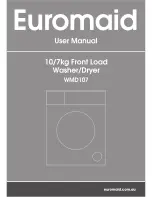
13
CARE AND CLEANING
Winterizing
A dishwasher left in an unheated place should
be protected f
rom freezing. Have a qualifi ed
person do the following:
To Disconnect Service:
1.
Turn off electrical power to the
dishwasher at the supply source by
removing fuses or tripping circuit breaker.
2.
Shut off water supply
3.
Place a pan under the inlet valve.
Disconnect water line from inlet valve
and drain into pan.
4.
Disconnect drain line from pump and
drain water into pan.
To Restore Service:
5.
Reconnect the water, drain, and electrical
power supply.
6.
Turn on water and electrical power
supply
7.
Fill both detergent cups and run
dishwasher through a HEAVY WASH/
cycle.
8.
Check connections to make sure they do
not leak.
NOTE
See Installation Instructions for more details
on disconnecting and restoring service to
your dishwasher.
ë
Before calling for service, review this
list. It may save you both time and
expense. This list includes common
experiences that are not the result of
defective workmanship or material in
your dishwasher.
Food Soils Left on Dishes
•
Choose another cycle for longer washing
time.
•
Check rack loading section for proper
loading-avoid nesting items.
•
Do not overload the dishwasher (See
Preparing and Loading Dishes).
•
Check to verify that the glass trap is
maintained and installed properly (See
Care and Cleaning).
•
Home water pressure may be too low-
should be 20 to 120 pounds per square
inch (psi).
•
Check incoming water temperature. It
should be about 120
o
F (49
o
C). (See
Factors Affection Performance).
•
Check water hardness. For extremely
hard water, it may be necessary to install
a water softener. (See Detergent Chart).
•
Use Fresh Detergent.
•
Make sure items are not blocking the
spray arms, preventing them from
rotating.
Dishes not Dry
•
By selecting Heat Dry, Hi-Temp Wash or
Sanitize options this will improve drying.
•
Make sure the rinse aid dispenser is
fi lled.
•
Increase the discharge setting of rinse
aid. (See Rinse Aid).
•
Check the incoming water temperature.
Be sure it is at least 120
o
F (49
o
C).
•
Check for proper loading-avoid nesting
items.
•
Plastic items may need to be towel dried.
•
Cups with a concave bottom will collect
water. Load them at the far left of the
upper rack so they will be held in a tilted
position.
•
Containers, bowls, pots/pans, and any
dishware with concave surfaces that can
collect water should be placed in the
rack facing or angled down so that water
is able to drain even from the lowest
point.
Glassware/Flatware Spotted or Cloudy
•
Check water hardness. For extremely
hard water, it may be necessary to install
a water softener. (See Detergent Chart).
•
Water temperature may be low. Avoid
extremely low or high temperatures.
(See Factors Affecting Performance).
•
Avoid overloading and improper loading.
(See Preparing and Loading Dishes).
•
Use fresh detergent. Old detergent is
ineffective.
•
Make sure rinse aid dispenser is fi lled.
•
Check to see that proper amount
of detergent is being used for cycle
selected. (See Detergent Dispenser).
•
Home water pressure may be too low-it
should be 20 to 120 pounds per square
inch (psi).
Before You Call


































